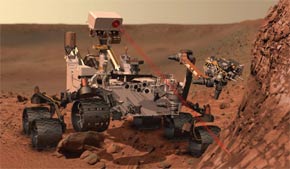 Most people living in the industrialized world — certainly Americans — enjoy the benefits of scientific progress. We like our iPads, HD TVs and GPS systems and are thankful for modern medicine and medical technologies. Even though we are surrounded by the fruit of scientific discovery, the day-to-day investigative and creative work of scientists goes largely unnoticed. It is only when something “big” happens or when some new gadget is introduced that most of us have any awareness of science and how it impacts our lives.
Most people living in the industrialized world — certainly Americans — enjoy the benefits of scientific progress. We like our iPads, HD TVs and GPS systems and are thankful for modern medicine and medical technologies. Even though we are surrounded by the fruit of scientific discovery, the day-to-day investigative and creative work of scientists goes largely unnoticed. It is only when something “big” happens or when some new gadget is introduced that most of us have any awareness of science and how it impacts our lives.
While it captured little attention outside the scientific community, on November 26, 2011, the stage was set for something big (and exciting) to happen in the world of scientific research — something so big it may forever alter our understanding of life itself.
At 10:00 AM EST on that date, NASA’s Mars Science Laboratory left the Cape Canaveral Air Force Station in Florida for its eight month, 352 million mile journey to Mars. The Mars Science Laboratory is mobile, similar to previous rover missions like the 1997 Mars Pathfinder mission with its Sojourner rover, and the 2003 Mars Explorer missions that included separate launches of two rovers, Spirit and Opportunity. On this mission, the rover is named Curiosity. It is due to set down on the surface of Mars, inside Gale Crater, at 10:31 PM, PST on August 5th.
Curiosity is twice as long and five times as heavy as Spirit and Opportunity. It is powered by an onboard reactor instead of solar panels, and its scientific instrument payload is vastly more sophisticated than those of previous missions. Curiosity’s complex payload includes a suite of instruments, appropriately named the Sample Analysis at Mars; an X-ray diffraction and fluorescence instrument called CheMin; a Mars Hand Lens Imager; an Alpha Particle X-ray Spectrometer; the Mars Science Lab Mast Camera; a Radiation Assessment Detector; an Environmental Monitoring Station; a Dynamic Albedo of Neutrons instrument; a Sample Acquisition/Preparation and Handling System, and my favorite—the ChemCam—which will be used to fire a high-energy laser into rocks as far away as 30 feet from the rover, vaporizing some of the rock so that the ejected material and excited atoms can be analyzed.
Curiosity’s primary mission is to assess whether its landing area on Mars (Gale Crater) has ever had or still has environmental conditions favorable to microbial life—both its habitability and its preservation. The complex instruments onboard Curiosity should provide rich data that might help scientists answer these questions.
University of New Mexico senior research scientist, Horton Newsom, is one of the team leaders overseeing the ChemCam laser that will study the geology of Mars, looking for possible signs of past life. “The previous Mars landers observed things that they could not analyze very well,” Newsom said, “There are many questions we have right now that we know we will be able to answer with vastly more sophisticated instruments.”
As you consider Curiosity’s mission, it is good to realize that the “big things” of science really only happen after years of dedicated, concentrated work by thousands of scientists like Dr. Newsom. Between the time spent with our iPads and cell phones, we should pause a moment to say “thank you.”
Editor’s Note: Mars is so far away that it takes 13.8 minutes for signals to travel from Curiosity to Earth. This creates unnerving operational challenges. To learn more, see our website homepage at aliveeastbay.com for the NASA video, “7 Minutes of Terror.”

Leave a Reply